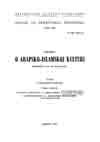Neke karakteristike učenja Ğalāluddin Rūmija i nastanak derviškog reda mevlevija, mevlevije u Bosni i Hercegovini
Some characteristics of the teachings of Ğalāluddin Rūmi, and begining of dervish order of Mawlawis, in Bosnia and Herzegovinia
Author(s): Džemal ĆehajićSubject(s): Christian Theology and Religion
Published by: Orijentalni Institut u Sarajevu
Summary/Abstract: In 1lhirs paper the author describes Gelaludin Rumi as the ideologue and originator of the Mevlevi brotherhood, analyzing his works and using the literature written about Rumi's mystical views, which were practically given the form of tarikat by his son Sultan Veled and which were also supplemented and further shaped by other representatives of the Mevlevi-tarikat in Konja. In the second half of his paper the author continues with his consideration of mevlevism, the significance of the Mevlevites in islamization and penetration of oriental culture and literature in Bosnia and Herzegovina and other parts of Yugoslavia. The article informs us that the Mevlevi-tarikat as an ideology and mystical movement was in existence as early as the 15th century, when the Mevlevi-Zavija was founded in Sarajevo (first at Šehova Korija and later at Bendbaša), at the beginning of the second half of the 15th century by Isa-beg Ishaković, governor of the so-called Western Parts (1440-1446) and the second Bosnian Sandžak-beg (1464-1469). A tekija was built on the right bank of the Miljacka River at the edge of Sarajevo even before Sultan Mehmed Fatih's campaign on Bosnia (1463), as can be seen from the vakufnama (dated between Felbruary 1 and March 3, 1462). It consisted of an entire cluster of buildings which served as a tekija and musafirhana - inn for overnight stay for poor Muslims, scholars, soldiers, and travelers. Food (meat, rice, and bread) was cooked there and distributed free of charge and what was left over was given to poor children of the city of Sarajevo. Guests were entitled to food for three days only. The Mevlevi-zavija in Sarajevo was also mentioned by Evlija Celebi in this Travels '(Seyahat-name) in the 17th century. His description speaks of the diverse activity of the tekija, with its various forms of rituals and functions and numerous members of the Mevlevi order. A very detailed and clear picture of the tekija was also handed down to us by the Sarajevo poet Rešid Efendi in his long poem about the disaster of Sarajevo caused by the campaign of Prince Eugene of Savoy in 1697, when the buildings of musafirhana and tekija suffered damage. The Sarajevo chronicler Mulla Mustafa Bašeskija recorded in his Chronicle that the tekija underwent restoration in the year 1196/1762. All the regulations of Isa-beg's vakufnama concerning the tekija were observed in full until 1878, when the Austrian occupational administration prohibited the keeping and maintenance of the musafirhana. During the last years of its existence the Mevlevi-zavija in Sarajevo was maintained with a subvention from the vakuf of Fadil-paša Šerifović, which prolonged its work and activities until 1924. In the Mevlevi tekija in Sarajevo, as long as it existed, and later in mosques and private houses, there were held sessions in Mesnevi of Gailaludin Rumi, which were conducted by such well-known representatives of the Mevlevi tarikat in Bosnia as Atik Dede, Tevekkuli Dede and others.
Journal: Prilozi za orijentalnu filologiju
- Issue Year: 1976
- Issue No: 24
- Page Range: 85-108
- Page Count: 24
- Language: Bosnian

